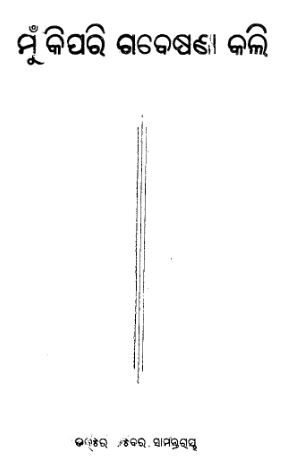Mun Kipari Gabesana Kali authored by Natabar Samantaray and published in 1982, stands as a significant contribution to Odia literature, specifically in the realm of essays. This book is a remarkable compilation that offers a blend of personal reflections, social critique, and cultural analysis, making it an indispensable part of the Odia literary canon. Samantaray’s work is notable for its eloquent prose and insightful observations that resonate deeply with the complexities of Odia identity and heritage.
The essays within “Mun Kipari Gabesana Kali” delve into various aspects of life in Odisha, shedding light on traditional practices, social issues, and the movement towards modernity. Through a series of sub-essays, Samantaray explores themes of cultural identity, the juxtaposition of tradition and modern influences, and the socio-political landscape of Odisha during the late 20th century.
Each essay serves as a reflective piece that not only articulates personal experiences but also critiques societal norms. Samantaray’s writing captures the essence of Odia life—its festivals, rituals, and the rich tapestry of customs that define the region. His keen eye for detail and ability to weave storytelling with critical analysis make the book a compelling read for anyone interested in the cultural dimensions of Odisha.
“Mun Kipari Gabesana Kali” offers readers an intimate glimpse into the mind of an Odia intellectual grappling with the challenges and triumphs of his people. Samantaray’s reflections go beyond mere observations; they invite readers to engage in a dialogue with the past and rethink their understanding of cultural identity. His approach is both personal and universal, encouraging a connection to the broader themes of heritage and belonging.
Through his critiques of societal norms, Samantaray bravely addresses issues such as caste dynamics, gender roles, and the impact of political changes on everyday life. He adeptly navigates the line between tradition and progress, often lamenting the loss of cultural richness in the face of globalization while simultaneously advocating for a balanced approach that embraces change without sacrificing identity.
The language employed by Samantaray is rich and evocative. His use of idiomatic expressions and local dialects enhances the authenticity of the narratives, allowing readers to feel the vibrancy of Odia culture. The prose is adorned with metaphors and similes that paint vivid pictures in the reader’s mind, making complex ideas accessible and relatable.
In conclusion, “Mun Kipari Gabesana Kali” by Natabar Samantaray is a seminal work that transcends the boundaries of conventional essay writing. It serves as a mirror reflecting the socio-cultural realities of Odisha while offering a critical lens through which to view the evolving identity of its people. The book remains relevant today, inviting new generations to engage with their heritage and to contemplate the balance between tradition and modernity. As a scholarly work, it is a testament to the power of language and thought, and it continues to inspire readers to delve deeper into the rich cultural tapestry of Odisha.
Books Info
| Books name | Mun Kipari Gabesana Kali/ମୁଁ କିପରି ଗବେଷଣା କଲି |
| Author | Natabar Samantaray |
| No Of pages | 302 |
| Publisher | NA |
| Publication | 1982 |
| Printed At | NA |
| Distributor | NA |

